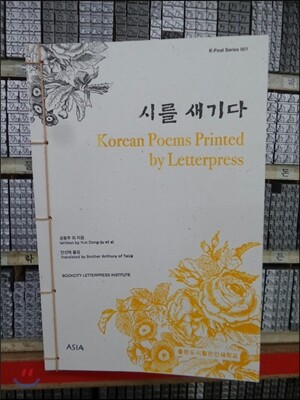Yi Sang-hwa (1901–1943) was a Korean nationalist poet active in the resistance to Japanese rule.
Life
Yi Sang-hwa, who sometimes published under the names Muryang, Sanghwa, and Baega, was born on May 22, 1901, in Daegu. Yi participated in the March 1st Independence Movement of 1919 in Daegu, which sought to restore Korean sovereignty. In 1921, wishing to study in France, Yi went to Japan to study French language and literature, but ended up returning to Korea in 1923 after the Great Kanto earthquake.
In the early 1920s Yi founded the Baekjo literary circle along with Hong Sayong, Park Chong-hwa, Park Yeonghui, Kim Ki-jin, and others. He published his first poems, "Malseui huitan" (말세의 희탄 Joy of the Corrupt Age), "Danjo" (단조 Monotony), and "Gaeurui punggyeong" (가을의 풍경 Autumn Sketches) in the inaugural issue of Baekjo, in 1922, followed by "Ijungui samang" (이중의 사망 Double Death), an elegy to his friend, the composer Park Tae-won, and "Naui chimsillo" (나의 침실로 Toward My Bedchamber), one of his most famous poems, in the 1923 issue.
The poet went on to form the literature study group PASKYULA with Kim Ki-jin and others, and in August 1925 he was one of the founders of the Korea Artists Proletariat Federation (KAPF). The next year he became managing editor of the KAPF journal Literary Arts Movement. In 1937 he went to Mangyeong to see his elder brother, General Yi Sang-jeong, but was arrested by the Japanese upon his return to Korea and jailed for four months. After his release, he taught at the Kyonam School (now Daeryun High School) in Daegu for a time before devoting himself to reading and study in order to produce an English translation of Chunhyangjeon (춘향전 The Tale of Chunhyang).
Yi died of cancer on April 25, 1943.
Writing
Yi Sang-hwa's poetic verse may well be an example of one of the most distinct departures in style in all of Korean literature. As a member of the Baekjo literary circle, made up of a school of romanticists, Yi's early poems involved heavy elements of prose and depicted a world of decadent sensibilities and narcissism. In his early poem "Naui chimsillo," for example, the poet contemplates committing suicide in order to attain true love, and in another, a life of reverie, completely cut off from reality, is presented as the most desirable goal possible.
In 1925, however, prompted by the growing concern that was the reality of Japanese imperialism in Korea, Yi made a sudden and decisive break with this poetic world. Assuming the identity of a nationalist poet, Yi began to write poems of defiance and resistance against colonial rule. Because the restrictions of the times were such that he felt himself unable to express his political frustrations directly, his views tend to manifest themselves in nature symbols such as expressions of the homeland's natural beauty and depiction of the plight of individuals, such as Korean immigrants to Manchuria, deprived of everything by their oppressors. The series of poems from this late period that include "Ppaeatgin deuredo bomeun oneunga" (빼앗긴 들에도 봄은 오는가 Does Spring Come to These Stolen Fields?) for example, reveal Yi's spirit of resistance in just this way.
이상화(1901~1943)는 대한민국의 시인이다.
생애
이상화는 1901년 대구에서 태어났다. 부유한 명문가에서 태어났으나, 7세에 부친이 세상을 떠난 후 유교적 분위기 속에서 백부의 엄격한 가정교육을 받으며 성장했다. 1915년 경성에 있는 경성중앙학교에 입학했다. 3학년 시절부터 인생과 우주에 대한 철학적 고민을 했으며, 강원도의 금강산 일대를 방랑했다. 1919년에 3·1운동에 참가하였다가 일본 경찰을 피하기 위해 고향의 친구인 소설가 박태원의 집에서 지냈다. 1921년에 현진건의 소개로 《백조》 동인에 참가하여 본격적인 문학 활동을 시작했다.
1922년 파리 유학을 위해 일본 동경에서 프랑스어와 프랑스 문학을 공부했으나 동경대지진으로 인해 귀국했다. 이후 《백조》의 동인으로서 〈말세의 희탄〉(1922), 〈단조〉(1922), 〈나의 침실로〉(1923) 등을 발표하며 활발한 활동을 했다. 사회주의자가 된 이상화는 1925년 카프 조직에 참여했으며, 1927년 의열단 이종암 사건에 연루되어 구금되기도 했다. 1937년에는 독립군인 형 이상정을 만나러 만경에 다녀온 후 구금되었으며, 이후 대구의 교남학교에서 교사로 일했다. 1940년에 학교를 그만두고 독서와 연구에 몰두했으나 병을 얻고 건강이 점차 나빠졌다. 1943년 세상을 떠났다.
작품세계
이상화의 초기 시들은 당시 《백조》 동인들의 공통점이라 할 수 있는 병적 관능과 퇴폐성이 짙다. 이러한 특징은 식민지 현실에 대한 인식과 직결되는 것으로, ‘님’과 ‘밝음’을 지향하면서도 어둠의 현실에 자리하고 있는 서정적 자아가 두드러진다.
이상화의 초기 대표작인 〈나의 침실로〉(1923)는 그의 문학적 열정과 감상적 태도를 동시에 보여준다. 화자의 애절한 정감과 간절한 절규, 영탄과 청유의 반복적인 어투는 긴박한 정조를 자아낸다. 특히 각 연마다 간절히 부르는 ‘마돈나’는 사랑의 대상이자 구원의 대상이라 할 수 있다. 이와 함께 ‘밤’, ‘침실’과 같은 시간, 공간적 시어를 통해 시 전체에 관능적 분위기까지 끌어낸다. 이러한 시인의 언어는 화자의 격렬한 감정을 적나라하게 표현할 수 있다는 점에서 한국 근대시의 형성 과정에 중요한 역할을 한다.
1920년대 후반에 이르러 이상화의 시는 내면의 정서를 탐닉하는 것에 그치지 않고 현실의 영역으로 시적 관심을 확대하였다. 대표작인 〈빼앗긴 들에도 봄은 오는가〉(1926)는 현실 세계를 포괄하며 새로운 삶의 가능성을 모색한다. ‘빼앗긴 들’과 ‘다시 찾아온 봄’이라는 현실적 공간과 도래할 이상적 시간을 대비하며 빼앗긴 국토에 대한 상실감과 그것을 회복시켜야 한다는 강한 의지를 표출하고 있다. 이를 통해 이상화는 초기의 비탄과 허무에서 벗어나 저항과 의지의 시적 표현을 보여준다.
주요 작품
1) 전집
이기철 편, 《이상화전집: 빼앗긴 들에도 봄은 오는가》, 문장, 1982.
김학동 편, 《이상화전집》, 새문사, 1987.
이상규, 신재기 편, 《이상화 문학전집: 산문편》, 북랜드, 2009.
이상규 편, 《이상화문학전집》, 경진출판, 2015.




